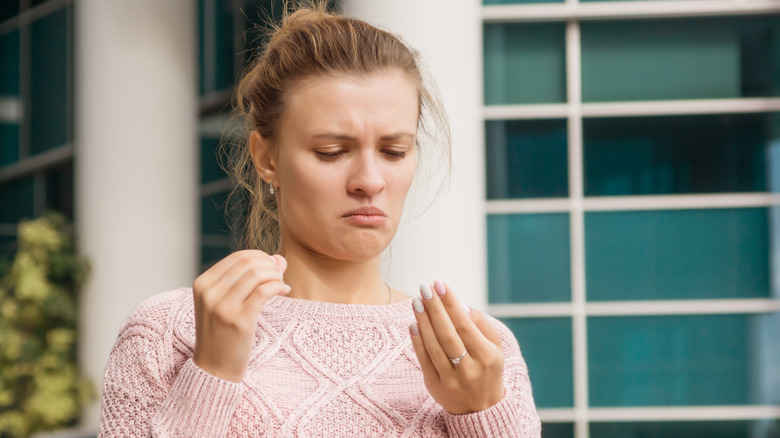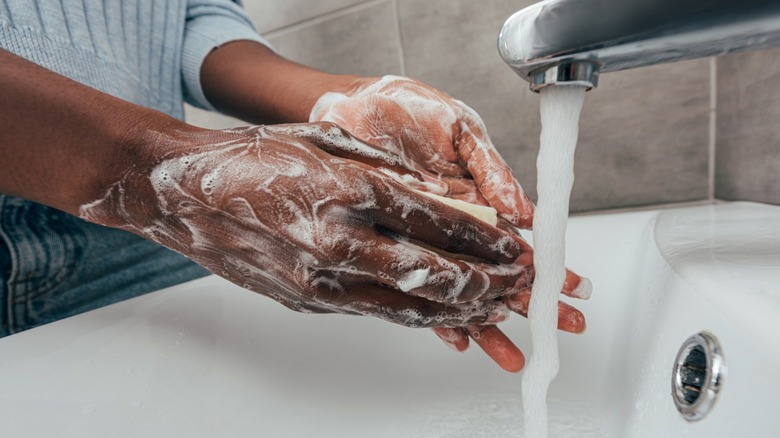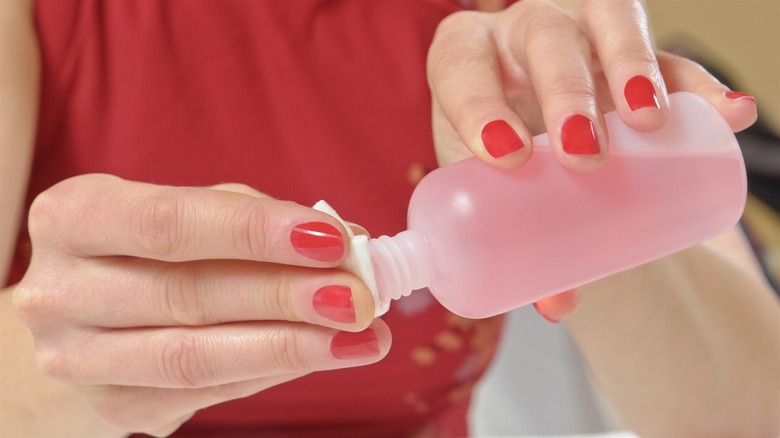Our Best Tips For Treating Skin Peeling Around Your Nails
Few sensations are as uncomfortable as peeling skin around your nails. At best, it's a nuisance, but at worst, it's painful — especially when the skin starts to crack and become raw, or when it gets caught on your clothes. What's more, it can be tricky to tell why it's happening; especially if you have a good nail care routine.
One of the most common causes of irritated skin on the hands and fingers is a cooler climate. Research shows that dry, winter air can weaken the skin's barrier function, in turn, causing dryness and irritation. If that's he case, you can usually fix your peeling problem by wearing gloves or thick socks. But cold weather may not be the culprit. Sometimes, it's lifestyle. Too many harsh chemicals on the skin, a general lack of moisturizing, and even your diet can cause your skin to flake. In other cases, peeling fingertips may be the result of medical conditions. Thankfully, there are some steps you can take to protect the skin around your nails from drying out and peeling.
Change up your handwashing routine
It's important to regularly clean your hands to slow the spread of germs, but over-washing can cause you to strip the lipid barrier on your skin, especially if you always use hot water. It's a commonly held belief that you need to wash with hot water, but there's actually no scientific evidence proving it's necessary. In fact, this practice can lead to dryness and cracked, peeling skin. To remedy this, try washing with cold water instead.
You may also want to check out the ingredients list on your soap bottle. Isothiazolinone, a common preservative, along with chemicals like sodium laureth sulfate are known to cause irritation and contact dermatitis in those with sensitive skin. Parabens and fragrance can also cause dryness. If you find yourself regularly dealing with peeled skin (and don't have any known conditions) try switching to a soap with a gentler formula. If you're worried about whether or not it will still clean properly, know that the U.S. Food and Drug Administration confirmed regular soap can be just as effective as its anti-bacterial counterparts.
Avoid acetone
We know, sometimes you can't escape acetone. It's in so many nail polish removers because it's one of the most effective and quickest ways to remove nail glue, gel lacquers, and dip powder. Unfortunately, acetone isn't the healthiest ingredient to bring into contact with your skin. "Acetone has a huge effect on the cuticle skin, which is a protector of your nail. Cuticle skin will dry out when exposed to acetone (cracking, peeling, bleeding)," Nail Lab Nail Technician Thea Phan explained to Sinclair Dermatology. This can also lead to dreaded hang nails.
If you're suspicious that acetone is cause of your peeling skin, consider switching to a soy-based polish remover. These are typically formulated with natural ingredients that are less irritating and moisturize the skin. However, keep in mind they may not work on gel polish. If that's the case, and your preferred manicure technique just can't be removed easily without acetone, the best solution may be to cut down on nail appointments all together. This way, your skin will have more time to recover between each polish change.
Visit your doctor to make sure your peeling skin isn't due to a medical condition
In most cases, skin peeling isn't anything serious to worry about. But if you've tried the above treatments and nothing seems to work, visit your doctor or dermatologist to make sure you don't have underlying health issues. According to Healthline, skin peeling could be the result of conditions like exfoliative keratolysis, Acral peeling skin syndrome, or even hand, foot, and mouth disease. In some cases, the problem could also be a result of eczema or psoriasis, which may require prescription treatments. Being deficient in vitamin B, niacin, or vitamin C, D, and E can also lead to skin peeling. Conversely, too much vitamin A could also cause dry skin. Mayo Clinic recommends women consume 700 micrograms per day, and 900 micrograms for men.
Although the only way to know for sure whether your vitamin levels are off is to have your bloodwork evaluated by a doctor, making small changes to your diet may help preserve your skin health overall and prevent dryness. Eating plenty of omega-3 fatty acids — which be found in fish, nuts, and seeds — is another great way to keep skin looking and feeling its best. Manhattan Dermatology and Cosmetic Surgery Centers' Dr. Marisa Garshick told British Vogue, "This will support a healthy skin barrier, which is our skin's outermost layer and plays an important role in regulating hydration levels of the skin."



